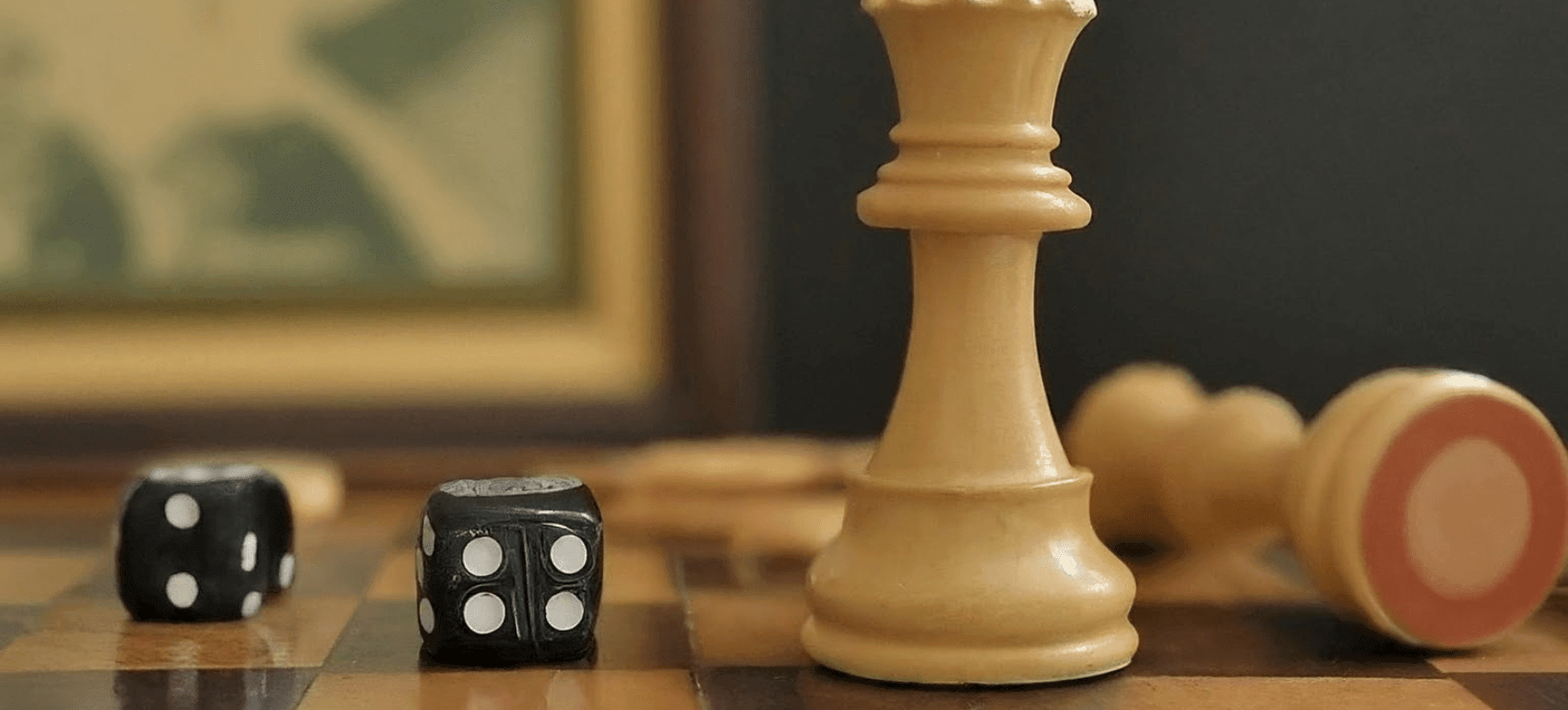
Strategic Bonding: How Chess and Backgammon Can Teach Life Skills During Family Game Nights
Introduction to Strategic Bonding through Board Games
In modern households, board games have emerged as more than just entertainment; they’ve become a conduit for strategic bonding and invaluable life lessons. This kinship is profoundly felt during family game nights, where classics such as chess and backgammon are not just games but tools for cultivating strategy, patience, and camaraderie among family members.
Strategic games, especially chess and backgammon, have a timeless appeal and can bridge generational gaps with their rich history and complex gameplay. They demand a blend of skillful planning, tactical execution, and on-the-fly decision making, mirroring many real-world scenarios that family members must navigate daily. Furthermore, these games provide a relaxed environment conducive to conversation, connection, and exchange of wisdom between players of all ages.
Chess, in particular, with its hierarchy of pieces from pawns to the king, reflects the dynamism of societal interaction. A set of large wooden chess pieces or luxury chess pieces can elevate the experience, transforming the game into an art form. Beautiful chess pieces are not just a delight to play with; they also serve as a symbolic gift for dad, embodying respect, thoughtfulness, and a shared passion for strategy.
Handmade and bespoke, a set of wooden chess pieces, art 809125, stands as a testament to craftsmanship and the love for meticulous strategy. These tangible objects often become heirlooms, carrying with them stories and lessons from countless games. Family game nights thus become a strategic bonding ritual, engraining life skills subtly through the guise of leisure, cementing the roles of these games as educational, as well as engaging, family traditions.
Exploring the History of Chess and Backgammon
The histories of chess and backgammon offer a fascinating glimpse into the past, revealing how these strategic games have evolved and endured through the ages. Chess, believed to have originated in India during the 6th century, has undergone many transformations. The game spread to Persia, where it became known as “shatranj,” with pieces that reflected the military hierarchy of the era. After making its way to Europe, the game evolved into its current form around the 15th century. This rich history is often appreciated by connoisseurs who invest in exquisite artifacts such as a set of large wooden chess pieces or luxury chess pieces that not only serve as a challenging game but also as an ornament of cultural heritage.
Backgammon, with roots dating back nearly 5,000 years, is one of the oldest known board games. Originating in the region of present-day Iran, the game traveled across empires and continents, evolving with each culture it touched. It remained a popular pastime through Greek and Roman civilizations, symbolizing status and intellect.
Today, both games continue to captivate players around the globe. The demand for beautiful chess pieces as a gift for dad, for instance, or the interest in adding a set of wooden chess pieces, art 809125, to one’s collection is a testimony to the timeless allure of these strategic games. Often, these boards and pieces are painstakingly handmade, infused with the skill and tradition of artisanal craftsmanship.
Players who engage in chess and backgammon not only partake in historical pastimes but also weave themselves into the tapestry of a millennia-old legacy. These games, passed down through generations, carry life lessons of strategy, foresight, and patience, demonstrating their perpetual relevance in teaching vital life skills.
Chess: A Metaphor for Life’s Strategic Decisions
Chess, often referred to as the game of kings, embodies the essence of strategy and foresight. This ancient game mirrors life’s multilayered decisions with its intricate tactics and competitive nature. Every move on the chessboard can parallel the choices one encounters in real life, from the simple to the complex. For example, deciding to trade pieces is akin to weighing the pros and cons of a career change or investment.
The large wooden chess pieces on the board represent different facets of an individual’s life. The pawns symbolize the foot soldiers of our daily tasks – seemingly insignificant yet vital in the march toward ultimate success. The knights, bishops, queens, and kings are akin to the impactful, larger decisions of life that require deeper thought and strategy. One can’t help but be reminded of the beauty and artistry of life when they observe a set of wooden chess pieces, especially if they’re handmade with attention to detail and craftsmanship.
Moreover, luxury chess pieces can act as a reminder that each piece in our personal and professional lives has its unique value, just like in a game of chess. From the opening gambit to endgame tactics, players learn the importance of planning, sacrifice for greater goods, and adapting to swiftly changing circumstances. Finding the perfect move in a challenging game resonates with discovering the right path amidst life’s twists and turns.
Perhaps on the next family game night, as parents gift for dad a beautiful chess set, they can introduce not only a fun activity but a learning moment. Art 809125 can be more than a game number; it can also symbolize a tapestry of life lessons woven through the gameplay. The handmade chessboard becomes a stage for understanding how individual choices relate to larger outcomes—a foundation not only for game strategy but for life’s myriad decisions.
Backgammon: Calculated Risk and Probability in Every Move
Backgammon, much like the elegant dance of handmade wooden chess pieces across a board, demands a refined appreciation for strategy and risk management. Players must constantly analyze probabilities and make decisions that balance potential rewards against possible hazards. Each roll of the dice in backgammon is an invitation to exercise calculated risk-taking.
In the fabric of backgammon strategy, numerical odds are the threads that players must weave into a tapestry of victory. Understanding the likelihood of various dice rolls and how they align with the positions of the checkers is crucial:
- Confronting adversaries on the board, backgammon participants gauge whether to advance checkers aggressively, potentially leaving them vulnerable, or to proceed with caution, fortifying their positions.
- The choice to leave a blot—a lone checker on a point—and the risk of it being captured by an opposing piece, plays against the statistical probabilities of the roll outcomes. A well-planned risk can become a strategic trap for an unwary opponent.
Moreover, the art of the double—the option to offer the doubling cube, increasing the stakes of the game—intertwines with risk assessment, demanding a clear-sighted evaluation of the game state relative to the dynamics of chance.
Backgammon’s inherent reliance on the whims of chance does not reduce it to mere gambling. Rather, it elevates the game to an intricate ballet of decisions where players must constantly adjust their tactics in the face of evolving odds. Whether played with a simple set or a collection of luxury backgammon sets—such as the distinguished Art 809125—a session of backgammon reinforces an understanding of probability and risk that mirrors many real-life situations, making it more than just a pastime, but a gift of wisdom for all ages.
Developing Critical Thinking and Problem-Solving Skills
Family game nights with chess and backgammon are more than just recreational activities. They serve as an intellectual gymnasium where participants, young and old, can develop critical thinking and problem-solving skills. These board games, especially when played with a set of large wooden chess pieces or beautiful chess pieces, can generate a sense of sophistication and luxury that further enhances the learning experience.
Chess—A Mental Workout
A game of chess requires a player to think several moves ahead, weighing the consequences of each possible action. It’s a dynamic puzzle where each decision can lead to victory or defeat. Whether employing luxury chess pieces or a handmade chess set, the game stimulates the mind to:
- Recognize patterns and understand the significance of strategic positioning
- Evaluate the initiative and make decisions under time constraints
- Anticipate opponents’ moves and intentions, fomenting foresight
- Consider the value of sacrifice for longer-term gains—a reflection of real-life decision-making
This parallels life experiences where long-term planning and the ability to adaptively recalibrate one’s strategy are crucial.
Backgammon—Strategic Flexibility
In backgammon, the randomness of dice throws adds an element of unpredictability, imitating real-world unpredictability. A player armed with a set of wooden chess pieces art 809125, designed to double as backgammon pieces, can enjoy a tactile resonance that brings the abstract challenges to life. Players learn to:
- Cultivate resilience through risk assessment and adaptation to chance events
- Develop strategic planning as they decide when to be defensive and when to go on the offensive
- Build patience and discipline, since impulsive moves can lead to disadvantageous positions
Through these activities, children and adults enhance the essential life skills of critical thinking and problem-solving. Chess and backgammon might just be the perfect gift for Dad or any family member—tools for enjoyment and personal development in one elegant package.
The Role of Patience and Long-Term Planning in Games and Life
In the realm of strategy games as well as the journey of life, patience and long-term planning are invaluable allies. A beautiful chess set with luxury chess pieces, adorning a family game night, provides more than aesthetic value; it serves as a battleground for cultivating these vital skills. Handmade wooden chess pieces artfully crafted under the designation of art 809125 become symbols for the methodical strategies employed in each move.
Similarly, when families gather to roll the dice and move their checkers during a backgammon match, they’re engaging in more than a simple game. Here, participants learn to anticipate their opponent’s moves and understand the importance of calculated risks—all substantial life lessons.
-
Patience:
- In both games and life, instant gratification must take a back seat to considered actions. Players learn that swift movements often lead to demise, while patient observation allows for seizing the opportune moment.
- Individuals acquire the ability to wait for the right time to implement critical decisions, be it moving a set of large wooden chess pieces across the board or waiting for the perfect moment to launch a new project at work.
-
Long-Term Planning:
- Strategic foresight demands that participants not only focus on the immediate but also plan several steps ahead. This forward-thinking approach is key whether one is navigating the complex positions of luxury chess pieces or setting life goals.
- The gift for dad or any family member isn’t just a set of wooden chess pieces, but a lesson in the value of long-term thinking—understanding that today’s sacrifice can lead to tomorrow’s success.
In essence, these time-honored games impart a framework for the thoughtful allocation of resources and timing—skills integral for success in both personal and professional spheres. Through strategic bonding during family game nights, patience and long-term planning are recognized and celebrated as the cornerstones of both intellectual pursuit in games and the grander game of life.
Emotional Intelligence: Managing Victory and Defeat
Family game nights are not just a time for bonding but also a critical period for developing emotional intelligence. Chess and backgammon exemplify this, as they offer clear moments of victory and defeat. Dealing with both outcomes graciously is a life skill that reverberates far beyond the game board.
When a family gathers around a set of large wooden chess pieces, the room becomes a stage for emotional learning. Each move with these luxury chess pieces can lead to a victory or defeat. Players learn to manage their emotions, whether they are basking in the success of a well-laid plan or facing the humility of an unexpected checkmate. Emotional restraint and empathy are cultivated, as individuals realize that gloating or despair can affect the atmosphere and relationships within the family.
Backgammon, with its combination of skill and luck, teaches resilience and adaptability. A sudden shift in dice rolls can turn the tide of the game, prompting players to cope with changing fortunes. The beautiful chess pieces and artful backgammon sets (art 809125) serve not only as a gift for dad but as tools for teaching how to maintain composure in the face of life’s unpredictability.
Participants learn the following during game nights:
- To offer and accept congratulations with humility and grace.
- That effort and strategy are sometimes thwarted by chance, much like in life.
- To identify and regulate emotions after a loss, transforming it into a learning experience.
- How to motivate oneself and others, recognizing that with every defeat, there’s an opportunity for victory in the next round.
This aspect of emotional intelligence developed through family games becomes a cornerstone for personal and professional relationships, empowering individuals to navigate the highs and lows with equilibrium and understanding.
Understanding Opponents: Perspectives and Empathy Through Play
Chess and backgammon are not merely games of skill and strategy; they are also profound teachers of interpersonal understanding. Engaging in a family game night with a set of large wooden chess pieces or engaging in the art of backgammon with beautifully crafted pieces encourages participants to slip into the minds of their opponents. The act of prediction, a core component of these games, necessitates an understanding of the other player’s perspective, intentions, and potential strategies.
- In chess, each move with luxury chess pieces on a richly varnished board isn’t just about advancing one’s position; it’s about empathizing with the opponent’s responses and future maneuvers.
- Similarly, successful backgammon play requires the foresight to not only execute one’s own game plan but also to anticipate and adapt to the opponent’s dice rolls and movements.
This gameplay can foster a unique form of empathy. One learns to respect the opponent’s thought processes, which can translate into valuable life skills off the board. The subtle art of perspective-taking during these games enriches player interactions and enhances emotional intelligence.
Family game nights become more than casual bonding experiences when they include a handmade gift for dad like a set of wooden chess pieces bearing the artistry of artisanal skill (art 809125). They transform into sessions where family members learn about one another—recognizing fears, strengths, strategies, and the unspoken language of silent contemplation.
This sensitivity towards an opponent’s perspective extends beyond the game. It permeates everyday interactions, teaching players, especially younger family members, the importance of understanding and empathy in all human relationships.
Interpersonal Connection: Strengthening Family Ties with Turn-Based Games
In an era where digital distractions are rife, families often seek ways to foster deeper connections. Turn-based games like chess and backgammon offer a unique opportunity to enhance family bonds through strategy and shared learning.
Chess is not merely about moving a set of large wooden chess pieces across a checkered board; it’s an exercise in patience and forethought. Luxury chess pieces, often handcrafted, add an aesthetic value that can turn a simple game into a cherished family heirloom, making it an inspired gift for dad or any family member. Art connoisseurs might appreciate the elegance of a set of wooden chess pieces art 809125, transforming the game from a pastime into a display of craftsmanship.
Backgammon, with its mix of chance and strategy, encourages members to engage in healthy competition and risk assessment. As with chess, the tactile nature of the game—rolling dice, moving checkers—creates a shared sensory experience that electronic games can’t replicate.
Here are ways that turn-based games strengthen family ties:
- Encouraging Communication: Family members verbally interact as they discuss possible moves and strategies, leading to improved conversational skills.
- Teaching Patience: Waiting for one’s turn fosters patience, particularly beneficial for younger family members.
- Advancing Planning Skills: Players think ahead, planning moves and adaptive strategies, which can translate to life skills.
- Bonding Through Tradition: Establishing a regular family game night with beautiful chess pieces creates a tradition that can be passed down through generations.
- Building Empathy: Observing and anticipating opponents’ feelings and reactions can enhance empathy among family members.
- Promoting Fairness: Rules and turn-taking instill a sense of fairness and respect for others.
Incorporating handmade or luxurious elements into these games turns an ordinary activity into an extraordinary bonding experience, where the value lies not only in the aesthetic beauty of the pieces but also in the shared moments they create.
Educational Benefits of Chess and Backgammon for Children and Adults
Engaging in strategic games like chess and backgammon presents a myriad of educational benefits for both children and adults. These games, often crafted as aesthetically pleasing artworks such as a set of large wooden chess pieces or the luxurious art 809125 backgammon sets, not only adorn one’s home but also contribute to cognitive development and strategic thinking.
Chess - The Game of Kings
- Strategic Thinking – Chess requires foresight and the ability to plan several moves ahead, enhancing problem-solving skills.
- Concentration – The game hones the ability to focus, important for both academic and professional success.
- Memory Improvement – Players must remember the opponent’s moves and strategies, thereby strengthening memory.
- Math Skills – Chess involves an understanding of geometrical concepts and calculations, indirectly bolstering mathematical prowess.
- Patience and Discipline – The game teaches players to be patient and to follow the rules meticulously.
Obtaining a beautiful chess set, potentially as a gift for dad or a relative, not only supports bonding but also encourages the learning of these life skills through play.
Backgammon - A Blend of Strategy and Chance
- Risk Assessment – Players learn to assess and take calculated risks, a useful skill in real-life decision-making situations.
- Probability – The dice component of backgammon introduces the concept of probability, crucial in logical thought processes.
- Adaptability – With each roll of the dice, players must adapt strategies, reinforcing flexibility and critical thinking.
- Social Interaction – Backgammon often encourages conversations and interaction, critical for emotional intelligence development.
- Coping with Randomness – Dealing with the chance element helps individuals learn to manage the unpredictability inherent in life.
Whether it is through a handmade chess set or a deluxe backgammon board, integrating these games into family game nights can be educationally advantageous while fostering lasting bonds.
Adapting Game Strategies to Real-World Challenges
Engaging in family game nights with board games such as chess and backgammon is not merely about entertainment but also about instilling life skills through strategic play. The process of learning and using effective strategies in these games provides invaluable insights into handling real-life challenges.
Enhancing Decision-Making: Throughout a game of chess, players must assess the board, anticipate their opponent’s moves, and counteract them effectively. Handling a set of large wooden chess pieces is akin to managing various factors in a real-world scenario. By constantly making decisions that affect the immediate state of the game, players develop a keen sense of judgement that translates into informed decision-making in life’s complex situations.
Risk Assessment: Backgammon requires players to evaluate risks and rewards with every roll of the dice and subsequent move. This mirrors real-life circumstances where weighing the potential outcomes of a decision is crucial. The skill of analyzing possible risks against the intended goals is sharpened, fostering an agile and analytical mindset.
Strategic Planning: Possessing a beautiful chess set, like the luxury chess pieces or art 809125, can be a gift for dad that also serves as a strategic learning tool. Constructing a long-term strategy while remaining flexible to modify tactics is a core aspect of chess. This parallels project management and personal goal-setting in life, where a clear plan must be adaptable to unexpected changes.
Problem-Solving: Both chess and backgammon involve problem-solving, requiring players to anticipate and overcome obstacles. These cognitive exercises improve the ability to identify problems, generate alternatives, and implement solutions effectively outside the game.
Emotional Resilience: The ebb and flow of game momentum teach players to manage emotions and cope with setbacks. This trains individuals to maintain composure and resilience, qualities essential for facing adversities in real-life situations.
By integrating the strategic elements and mental disciplines from these board games into everyday challenges, individuals can enhance their ability to navigate complex personal and professional landscapes with greater ease and confidence. The lessons learned over the gameboard are profound, extending far beyond the bounds of leisurely activity and into the heart of daily existence.
Building Resilience: The Psychology of Bouncing Back in Games
In the realm of board games, particularly those as strategic as chess and backgammon, resilience is a psychological muscle that players often develop subconsciously. Engaging in family game nights with these time-honored classics instills a robust mindset that is crucial for facing life’s unpredictable challenges.
Handling a set of large wooden chess pieces or luxury chess pieces during a tense game can mirror life’s pressures. When a player sees their beautifully crafted army besieged, resilience guides them to pivot strategies, much like adapting to life’s hurdles. Possessing a set of wooden chess pieces, art 809125, or an exquisite backgammon board serves not just as a pastime, but as a training ground for mental toughness.
Moreover, gifting a set of large wooden chess pieces to a dad or a loved one is more than a kind gesture; it is an invitation to build resilience together. Through this gift, players can learn from their losses, reframe setbacks as opportunities for growth, and develop the confidence to try new tactics.
Here are several ways in which chess and backgammon foster resilience:
- Embracing Failure: Losing a pawn or having a checker taken can teach players to embrace failure as a part of growth and learning. This attitude helps individuals become more resilient in the face of personal or professional setbacks.
- Problem-Solving: The core of being resilient lies in problem-solving. As players navigate the complexities of the game, they exercise their ability to work through challenges, a skill that translates well into everyday life.
- Staying Calm: Stressful situations in games demand calm thinking. Practicing this during play can help individuals remain composed during life’s stressors.
- Adapting to Change: Games are dynamic and ever-changing, demanding players to adapt their strategies. Likewise, resilience involves adapting to change and making the best of new circumstances.
- Delayed Gratification: Both games teach the value of patience and delayed gratification. Working towards a long-term goal and remaining steadfast in the face of adversity is a hallmark of a resilient individual.
Through the intricate dance of chess pieces and the strategic moves in backgammon, participants can imbue their thinking with resilience. In turn, these life skills acquired enhance personal development and fortify one’s capacity to rebound from life’s challenges.
From Game Night to Life Goals: Transferring Skills from Board to Boardroom
Family game nights are often associated with fun and bonding, but they can also serve as critical training grounds for developing essential life and professional skills. Chess and backgammon, in particular, are not merely entertainment; they are conduits for learning strategies that are invaluable in the boardroom.
Decision-Making and Planning: In chess, every move is a decision that can have long-term consequences. Similarly, in business, strategic planning and foresight are essential. Players learn to anticipate the opponent’s moves, which translates into anticipating market changes or competitor actions.
Risk Assessment: Backgammon teaches the assessment of risk and reward. Professionals must frequently analyze the potential outcomes of their choices and gauge whether the risk is worth the potential reward.
Problem-Solving: Both games involve solving problems under pressure, a skill that is directly transferable to overcoming challenges in the workplace.
Patience and Concentration: A set of large wooden chess pieces requires careful handling, teaching players the virtues of patience and focus. These attributes are crucial when addressing complex projects at work.
Emotional Intelligence: Understanding the opponent’s strategy and reactions can leverage success, much like reading a client’s or colleague’s emotional cues during negotiations.
Adapting to Changing Scenarios: In backgammon, the roll of the dice introduces chance, and players must continuously adapt their strategies. In business, change is the only constant, and adaptability is key.
A handmade luxury chess board with beautiful chess pieces can be more than a gift for dad; it’s an investment in building his strategic acumen. Similarly, presenting a set of wooden chess pieces, such as Art 809125, can signify the start of a journey towards mastering life skills. From game night to the boardroom, the parallels are clear, and the lessons are impactful.
Conclusion: Integrating Lessons from Chess and Backgammon into Everyday Life
Chess and backgammon are not just games of strategic interaction; they are conduits for life-enhancing skills that can be seamlessly woven into the fabric of daily experiences. Playing these games can cultivate patience, strategic thinking, and risk assessment.
In the case of chess, with every decision involving a set of large wooden chess pieces, players learn the value of foresight and planning. When dealing with intricate problems, individuals can channel their experiences from the chessboard, examining each component with precision and thoughtfulness. This echoes in the selection of luxury chess pieces, where discernment can make all the difference. Similarly, gifting beautiful chess pieces, such as art 809125, to a father, is not just a gesture of affection but also an invitation to engage in cognitive development and bonding.
Backgammon, meanwhile, emphasizes adaptability and probability evaluation. Its unpredictability mirrors life’s own caprice, teaching players to remain resilient and flexible. Individuals can apply the lessons of backgammon to personal finance management, as it encourages a measured approach to investment and savings.
Furthermore, navigating the complexities of these games allows families to foster deeper connections. Game nights become a safe harbor where members can challenge each other respectfully and supportively. As they roll the dice or ponder over a move, the underlying factor remains a nurtured family unit through shared experiences.
In essence, the intellectual and emotional disciplines fostered by chess and backgammon transcend mere entertainment. As individuals, and as families, embracing the strategic bonding these games offer can resultantly improve decision-making, enhance interpersonal relationships, and enrich the overall quality of everyday life.






